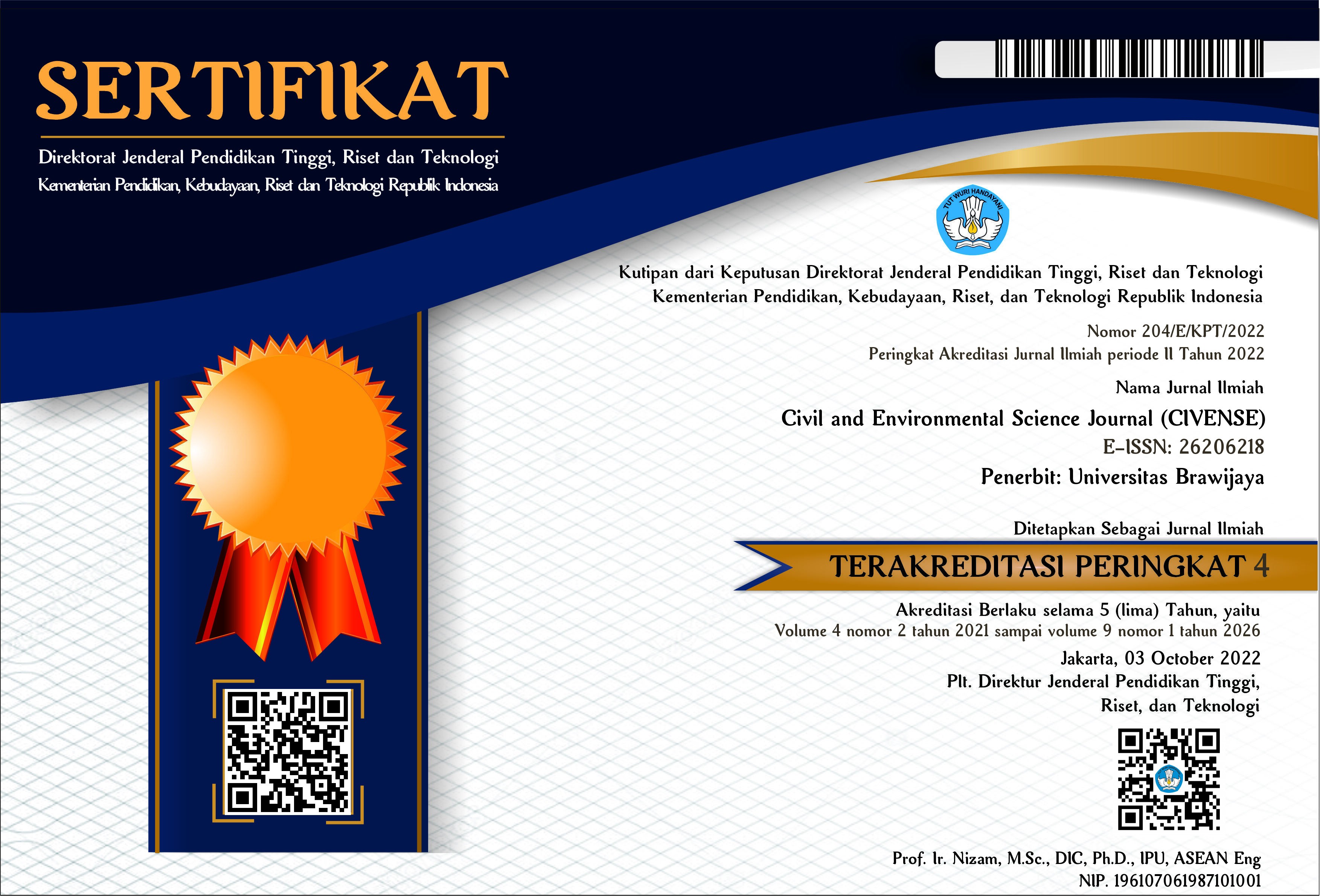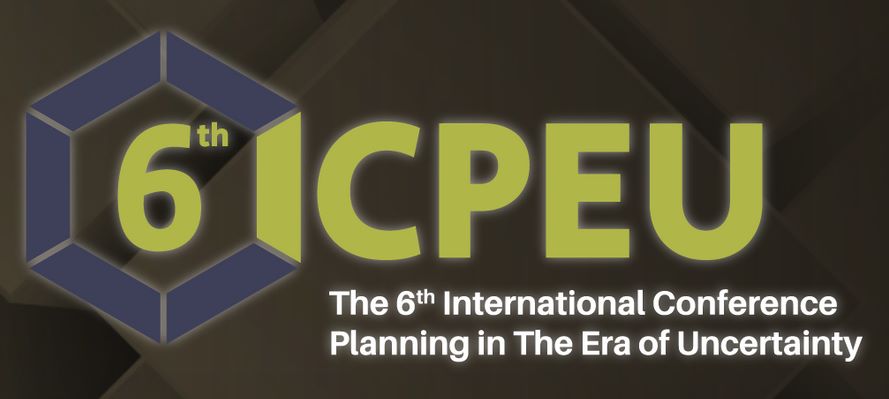Analysis on The Effect of Groyne Type Impermeable Placement on Sediment Distribution in Lariang River Bend
DOI:
https://doi.org/10.21776/ub.civense.2021.00401.5Keywords:
erosion, groyne, river bends, sedimentationAbstract
Sedimentation and erosion caused by differences in discharge is a problem that often occurs at river bends. One of the functions of placing the groyne is to reduce the river flow velocity along the riverbank, accelerate sedimentation, and ensure the embankment or river bank's safety against scouring. This study aimed to determine the distribution of current velocity, distribution of riverbed shear stress, and sediment distribution to the effect of groyne placement. There are 7 (seven) simulation models used to get the most effective groyne placement. From the model simulation results by adding a groyne building on the river's outer bend for the simulation model scenario 2 to scenario 7, the largest sedimentation production is in scenario 3, namely the height of riverbed sediment deposits 230 hours of 1.094 m. Furthermore, the groyne building's effective placement is determined based on a maximum change in the riverbed scenario. In scenario 3, the placement and dimensions of the groyne length of 17.5 m; distance between groyne 24.4 m; the groyne is inclined upstream in the direction of flow 10°.
References
B. Triatmodjo, Hidrologi Teknik Terapan, Yogyakarta: Beta Offset, 2010.
C. Asdak, Hidrologi dan Pengelolahan Daerah Aliran Sungai, Yogyakarta: Gajah Mada University Press, 2002.
L.F. Ideawati, L.M. Limantara, and U. Andawayanti. “Analisis Perubahan Bilangan Kurva Aliran Permukaan (Runoff Curve Number) Terhadap Debit Banjir Di Das Lesti,” Journal Of Water Resources Engineering. Vol. 6, No. 1, 2015.
Perum Jasa Tirta (PJT) I, “Kajian Kapasitas Tampungan Waduk Sengguruh-Sutami- Lahor dan Wlingi-Lodoyo”. Malang: Research by Berau of Research and Development PJT I, 2015.
Nurdiyanto, L.M. Limantara, and E. Suhartanto. “Analisis Hujan dan Tata Guna Lahan Terhadap Limpasan Permukaan Di Sub DAS Pekalen, Kabupaten Probolinggo,” Journal Of Water Resources Engineering, Vol. 7, No. 1, pp. 83-94, 2016.
M.N. Fikriy, L.M. Limantara, and E. Suhartanto. “CN Modeling for Predicting Discharge in Lesti Sub-watershed,” Intl. Journal of Innovative Tech. and Exp. Eng, Vol. 8, Issue 12, pp 4890-4896, Oct 2019.
A. Prakoso, S. Marsudi, and Sumiadi. “Analisis Laju Erosi Dan Usaha Konservasi Lahan Di Das Bogel Kabupaten Blitar Berbasis Sistem Informasi Geografis (SIG),” in Water Resources Engineering. Brawijaya University Website, [online document], 2016. Available: http:// pengairan.ub.ac.id/. [Accessed Januari 3, 2021].
S. Tikno, T. Hariyanto, N. Anwar, A. Karsidi, and E. Aldrian. “Aplikasi Metode Curve Number Untuk Mempresentasikan Hubungan Curah Hujan Dan Aliran Permukaan Di DAS Ciliwung Hulu – Jawa Barat,” Jurnal Tek. Ling, Vol. 13, No.1, pp. 25 – 36, Jan 2012.
V.T. Chow, Hidrolika Saluran Terbuka, Jakarta : Erlangga, 1989.
S.L. Neitsch, J.G. Arnold, J.R. Kiniry, R. Srinivasan, and J.R. Williams, Soil And Water Assessment Tool User’s Manual Version 2000, Grassland, Soil and Water Research Lab. USDA Arigicultural Research Service, Temple, TX: Texas Water Resources Institute, 2002.
E. Suhartanto, Panduan AVSWAT 2000 dan Aplikasinya di Bidang Teknik Sumber Daya Air, Malang: Asrori, 2008.
E. Suhartanto, Panduan HEC-HMS dan Aplikasinya di Bidang Teknik Sumber Daya Air, Malang: Asrori, 2008.
LM. Limantara, Hidrologi Praktis, Bandung: Lubuk Agung, 2010.
Soewarno, Hidrologi Aplikasi Metode Statistik untuk Analisa Data, Bandung: Nova, 1995.
Haribowo R., Andawayanti U., Lufira R.D. 2019. Effectivity test of an eco-friendly sediment trap model as a strategy to control erosion on agricultural land. Journal of Water and Land Development. No. 42 (VII–IX) p. 76–82. DOI: 10.2478/ jwld-2019-0047.
Downloads
Published
How to Cite
Issue
Section
License
Copyright (c) 2021 Civil and Environmental Science Journal (Civense)

This work is licensed under a Creative Commons Attribution-NonCommercial 4.0 International License.
Authors who publish with this journal agree to the following terms:
Authors retain copyright and grant the journal right of first publication with the work simultaneously licensed under a Attribution-NonCommercial 4.0 International License that allows others to share the work with an acknowledgement of the work's authorship and initial publication in this journal.
Authors are able to enter into separate, additional contractual arrangements for the non-exclusive distribution of the journal's published version of the work (e.g., post it to an institutional repository or publish it in a book), with an acknowledgement of its initial publication in this journal.
Authors are permitted and encouraged to post their work online (e.g., in institutional repositories or on their website) prior to and during the submission process, as it can lead to productive exchanges, as well as earlier and greater citation of published work (See the Effect of Open Access).














